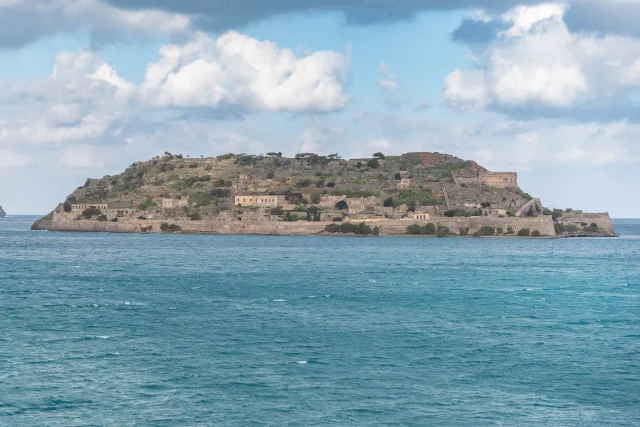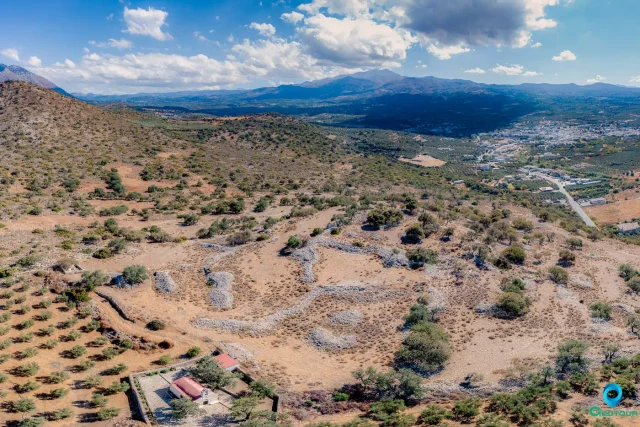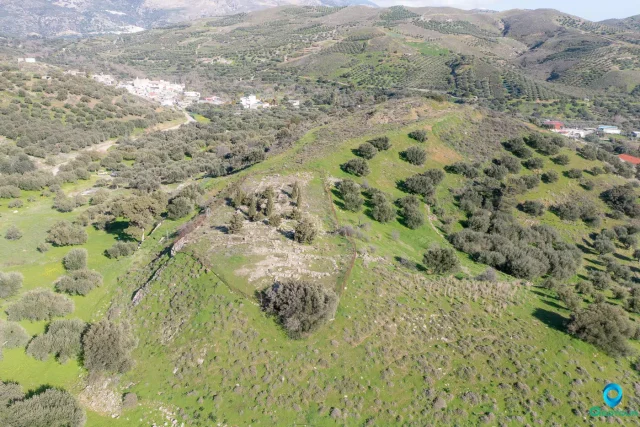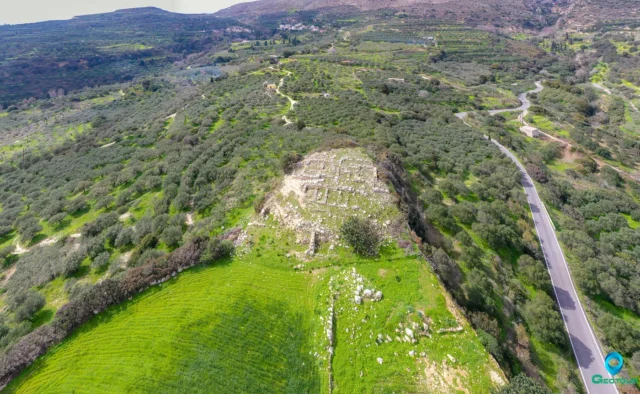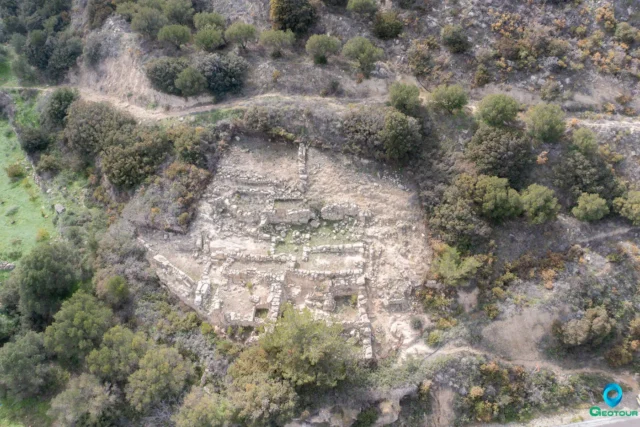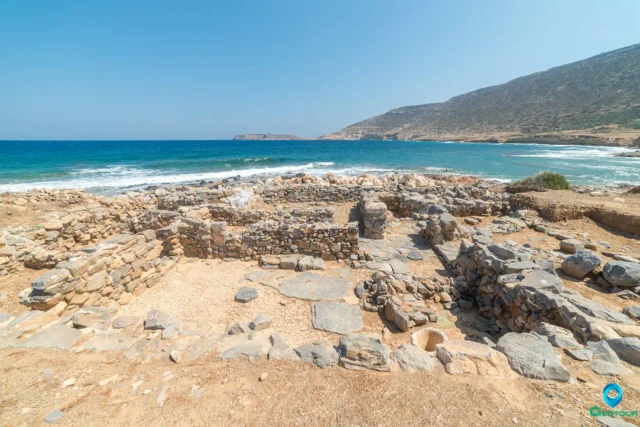107
listings found
Categories
Active filters:
Spinalonga
This rocky islet in the Gulf of Elounda, Lasithi (officially Kalydon), was a Byzantine watchtower linked to ancient Olous. The Venetians built it into a formidable sea fortress (1574-1586) which became their last stronghold, falling in 1715. It then became a thriving Ottoman commercial settlement, the largest Muslim center in the Mirabello region, until 1903. From 1903 to 1957, it was repurposed as a leper colony, a place of exile where patients formed a unique community, notably the "Brotherhood of Patients" (1936). Today, it is a protected archaeological site and on UNESCO's tentative list.
Grivila ancient city and Melidoni cave
An Early Iron Age settlement on a hill in the Mylopotamos plain, occupied into the Late Geometric period. The site featured tightly packed, single-story houses built with small stones and had beaten earth floors. Excavations unearthed finds like a bronze hoplite statuette, Geometric sanctuary figurines, and coarse pottery. The nearby Melidoni cave, a cult place since Minoan times, is thought to have served as the settlement's sanctuary, a common pattern in ancient Crete.
Phylaki tholos tomb
A Late Minoan III (LM IIIA-IIIB) funerary monument in Apokoronas, West Crete, significant for understanding Postpalatial society after Knossos's decline. Excavated by Yiannis Tzedakis, this large tholos tomb features a rare rectangular chamber and a vertical lintel plaque, an architectural trait shared with the Malame tholos. Despite being partly looted, it contained rich grave goods reflecting elite status, including ivory carvings of a footstool and figures with unique almond-shaped eyes, and sixteen antique hard stone seals.
Gaidourophas
Gaidourophas, a Minoan archaeological site in Crete, features a two-story building with evidence of large-scale storage and administration. It's a significant node in the network of Minoan mountain sites.
Kefali Chondrou
Located near Chondros Viannou, this multi-period archaeological landscape illustrates socio-political evolution in the Bronze Age. The complex uniquely demonstrates a transition from a sophisticated Neopalatial (MM IIIB-LM IA) country villa on the western hill to a large, post-palatial (LM IIIA1-2) town on the central hill following an earthquake around 1600 BCE. Excavations by Nikolaos Platon uncovered the 50-room town and significant ritual artifacts, including a triton shell and a rare plastic rhyton of a pregnant woman.
Syme (Symi) Viannou: Sanctuary of Hermes and Aphrodite
The Sanctuary of Hermes and Aphrodite at Syme Viannou, also known as Kato Syme, is an exceptionally long-lived and significant cult site in Crete. It is located on a plateau […]
Ancient Kissamos
The archaeological site, located in the ancient “Myrtilos” plain beneath modern Kastelli Kissamou, reveals occupation from the Minoan period. Initially the Hellenistic port for the inland city of Polyrrhenia, it grew into a major, autonomous Roman urban center (civitas libera). The Roman city featured a Hippodameian grid, luxurious villas with intricate mosaics, a theater, and advanced waterworks. Its prosperity ended with the 365 CE earthquake, which caused a tectonic uplift of up to nine meters, destroying the city and its harbor.
Ancient Lappa
Beneath Argyroupoli, Rethymno, between the Petres and Mousselas rivers, this city had Geometric to Byzantine occupation. A Roman civitas libera under Augustus, with Italian settlers and Agrippa's patronage, it faced Arab destruction (828 AD). Rescue digs revealed Hellenistic fortifications, homes, Roman baths, and a still-used cistern. Material culture includes skyphoi, Italian/Eastern sigillata, stamped amphorae (Rhodes, Knidos), local pottery, coins, and an Aphrodite statue. A key trade hub on Crete's Roman road.
Minoan Villa at Agios Georgios (Tourtouloi)
Situated on Prophitis Elias hill near Praisos in eastern Crete, Agios Georgios, also known as Tourtouloi, is the site of a 700 square meter Minoan villa constructed across four terraces during the Bronze Age, specifically the Proto- and Neopalatial periods (MMIII to LMIB). Excavated by Nicholas Platon, this 'villa' functioned as a central building within a small settlement focused on agricultural exploitation. The site, part of the Petras region's settlement hierarchy, features architectural remains including rooms on the second terrace and a wine press and possible kitchen on the lowest. Discoveries include numerous loom weights, indicating significant textile production, and a potter's wheel, suggesting localized pottery manufacture. While not well-preserved due to landslips and weather, Agios Georgios represents a second-tier 'villa' site within the Petras territory, highlighting agricultural and craft activities within the broader Minoan economic and cultural context of eastern Crete.
Zou Minoan Farmhouse
Zou, an eastern Cretan Minoan site, features a Neopalatial farmhouse spanning MM IIIB to LM IA.
Excavations, including Platon's 1955 work and a 2004 re-examination, uncovered dark-on-light pottery and Linear A script fragments. Architectural remains reflect Minoan rural building practices. The site's location and artifacts provide insights into the area's economic and social roles during the peak of Minoan civilization, including the period surrounding the Thera eruption. Studies of Zou, alongside sites like Achladia and Epano Zakros, contribute to understanding Minoan settlement patterns outside major palatial
Achladia Minoan Villa
Achladia, 3 km from Achladia village, presents Minoan House A, a 270 sq m structure, dated LM I & III. Excavations since 1939 revealed artifacts like amphorae and larnakes, illuminating Minoan life and burial practices. The site's rectangular design, potentially based on the Minoan foot, and its internal layout around anteroom A, reflect sophisticated planning. Debates persist on its function as a villa, due to simpler construction compared to central Cretan sites. Re-examinations in 2003 analyzed topography, materials, and spatial use, aided by digital reconstructions. The location's visual range and wind-protected orientation are noted. Building materials, like local limestone and marls, and techniques, including megalithic walls, suggest practical construction. Achladia offers insights into East Cretan Minoan architecture and socio-political structures, with its status as a villa under scholarly scrutiny.
Gournia Minoan settlement
Gournia, a Minoan town on Crete's north coast, presents a complete example of a small settlement.
Excavations, starting with Harriet Boyd Hawes, reveal houses, a palace, and a street network, reflecting Minoan urbanism. The site's history spans from the Neolithic to Late Minoan periods, witnessing growth, destruction, and limited reoccupation. Discoveries include artifacts, cemeteries (Sphoungaras, North), and architectural features like the 'Shore House,' suggesting maritime connections. The town's layout, with a main street and organized blocks, highlights urban planning. Gournia's cultural and economic context includes regional trade and religious practices. Ongoing projects reexamine its architecture, offering insights into Minoan civilization and its connections to other Aegean settlements.
Papadiokampos Minoan House
Minoan harbor town on Crete's coast between Mochlos and Petras, active from Protopalatial to Late Minoan I (LM I). Linked to nearby Petras, it suffered destruction in LM IB, possibly due to the Thera eruption. Excavations, particularly of House A.1, uncovered a two-story building, ceramics like cooking pots and evidence of seafood soup, stone tools (querns, pounders), and metal artifacts, suggesting sudden abandonment. Residents practiced farming (grapes, cereals, olives), fishing (notably shellfish), and wine production. Evidence from House B.1 points to metal and textile trade, indicating social stratification. Craft specialization included purple dye production.
Traostalos Peak Sanctuary
The Traostalos Peak Sanctuary, located 3.2 km from the palace of Zakros in Crete, dates back to the Final Neolithic period (1700-1450 BCE). The site, partially excavated, features votive offerings, terracotta figurines, animal replicas, a clay model of a ship, bronze needles, gold ribbons, various vessels, and Linear A inscriptions. The sanctuary's decline in LM IB coincides with the rise of the Zakros palace and other peak sanctuaries' abandonment, possibly due to ideological shifts, earthquakes, or the Thera eruption. The site's lack of monumental dedications or evidence of large-scale animal consumption suggests less political influence compared to other peak sanctuaries. The construction of the Zakros palace marked a shift towards a more hierarchical social and political organization, contrasting with the public ceremonies at Traostalos. The sanctuary's abandonment after the wider area's unification under the palace indicates its connection to the early stages of state formation in Minoan Crete.
Pelekita Cave, Zakros
Pelekita Cave, on Crete's east coast, features Neolithic and Minoan finds. Excavations reveal pottery, tools, and animal bones, detailing early Aegean life. Neolithic strata include debates on dating and regional connections to the Cyclades and Anatolia. The cave's use spanned from the Paleolithic to the Minoan period, with a volcanic ash layer linking it to the Thera eruption. Domestic features like hearths and a possible sheep-pen suggest varied uses. Ongoing analysis aims to clarify the cave’s chronology and significance, showing its role in understanding Crete’s prehistory. The cave contains five chambers, stalactites, stalagmites, and a freshwater source.
Livari Minoan coastal settlement
Livari, located on Crete's southeastern coast, is a significant archaeological site with evidence of human occupation from the Mesolithic to Venetian periods. The area, characterized by a coastal plain and low hills, includes sites like Cheromylia, Kastrokephalaki, and Chlios, revealing Minoan settlements and early hunter-gatherer activities. Archaeological campaigns have documented lithic assemblages from the Mesolithic, Bronze Age remains, and structures from the Classical/Hellenistic and Venetian eras, including a possible watchtower. Despite poor preservation, erosion, and vegetation cover, Livari provides crucial insights into early human activity, Minoan civilization, and cultural transitions in the Aegean. Studies document topography, structures, and landmarks, correcting misconceptions and emphasizing the site's importance for understanding Crete's broader archaeological context.
Azoria ancient settlement
Azoria, located on Crete, is an archaeological site revealing urban development from the Bronze Age to the Archaic period. Notably, it grew into a regional center during the Early Iron Age and reached its peak in the 6th century BC. Excavations show organized city planning, monumental buildings, and a shift from dispersed villages to a centralized settlement. The site experienced destruction by fire in the 5th century BC, followed by limited Hellenistic reoccupation. Azoria's stratification and botanical/faunal studies provide insights into socioeconomic changes and landscape transformations. Research highlights its role in Crete's urbanization, revealing changes in settlement patterns and social structures. The site's strategic location and architectural renovations underscore its importance in understanding the development of the Cretan polis.
Mochlos Minoan Settlement and Port
Mochlos, a small islet off Crete, was a significant Minoan port city with a long history. Settled from the Early Minoan period, it flourished in trade, particularly during EM III, evidenced by sophisticated crafts like pottery and metalwork. The site shows social stratification through its tombs. A decline occurred in the Middle Minoan period, but Mochlos revived in the Neopalatial period with a smaller town and ceremonial buildings. The town was destroyed in LM IB, though the site was reoccupied by Mycenaeans. Mochlos later became a major center for amphora production in the Roman era, exporting wine across the Mediterranean. Excavations continue to reveal insights into Minoan life and trade.
Ancient Lykastos
An ancient city in Crete, located at the Vitsilia site near modern Profitis Ilias and known primarily from literary sources. First mentioned in Homer's Iliad's Catalogue of Ships, its mythological founder was Lykastos, a son of King Minos. During the Hellenistic era, the city was destroyed by the neighboring city-state of Knossos. Its territory subsequently became a point of contention, with Gortys seizing it and granting it to Rhaukos. Roman intervention in 185 BCE ultimately divided the lands between Knossos and Lyktos.









